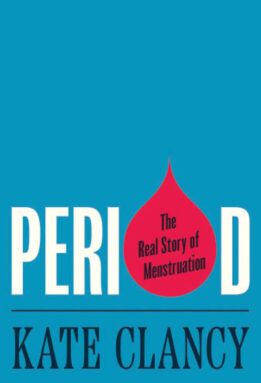
Period
Kate Clancy
Princeton Univ., $27.95
In a February golf tournament, after Tiger Woods hit his ball farther on the ninth tee than Justin Thomas, Woods handed Thomas a tampon. Get it? Thomas is weak! Haha.
Contrast this with the viral videos of writhing men hooked up to a menstrual cramp simulator created to bring awareness to period pain. When CBS News correspondent Jamie Yuccas’ producer tried the simulator set at the pain level Yuccas regularly experiences, he was visibly distressed. “Are you serious? This is your baseline?” he said, with a following comment bleeped out.
There probably aren’t enough cramp simulators to enlighten everyone who doesn’t menstruate. But here’s another option: Hand them a copy of Kate Clancy’s Period: The Real Story of Menstruation. Better yet, give this book to everyone. Getting accurate information about the why and how of periods is difficult even for those who do menstruate. There remains considerable stigma and revulsion toward this physiological event that half the population experiences during a large portion of life.
Clancy, an anthropologist at the University of Illinois Urbana-Champaign, studies the impact of environmental stressors on the physiology of menstruating people. In Period, she lays out the science of menstruation along with details on the reproductive cycle and the uterus. She also challenges readers to think about the research climate, dominated by white men, that has shaped the views of menstruation and the female reproductive system (SN: 4/9/22, p. 29).
“Given anthropology’s history of removing women from the hero myths of human evolution or never noticing their worth in the first place,” Clancy writes, “menstruation is worth a closer look.”
For example, Clancy lays out emerging evidence on menstrual priming, the idea that each time the body prepares the lining of the uterus for a possible embryo and then repairs the lining during menstruation, it’s conditioning the uterus to better provide a rich and nourishing site for an eventual pregnancy. In other words, periods serve an evolutionary purpose. It’s not just the body expelling the lining because it’s reached the end of its shelf life, as a major hypothesis contends.
Clancy also discusses the long history of viewing menstruation as polluting. A popular “medical” textbook from medieval times contended that menstruating women emitted dangerous fumes that could “poison the eyes of children lying in their cradles by a glance.”
color: black;
margin-top: 0px;
background-image: url(“”);
background-size: cover;
padding: 20px;
border: 1px solid #ffcccb;
border-top: 5px solid #e04821;
clear: both;
}
This notion has persisted. In 1920 in Vienna, a doctor named Béla Schick claimed that menstruating women secreted toxins, after a series of experiments in which such women handled flowers that then wilted. These “menotoxins” became a go-to explanation for a number of women’s illnesses — as well as the ailments of those who were nearby a menstruating woman — for decades. Poisonous fumes all over again.
Of course, “menotoxins” aren’t real. But the idea that menstruation is polluting still shapes attitudes. Clancy writes of a 2002 study in which a participant was paired with a woman, an actor playing a participant. After reaching into her handbag, the actor would accidentally drop either a tampon or a hair clip. In questionnaires, the participants who had seen the tampon rated the woman less capable and likeable. And in a sign of disgust, participants were more likely to sit away from the actor after she had dropped a tampon than after she had dropped a hair clip.
Considering the stigma, it’s no surprise that menstruating people tend to hide their periods. To change attitudes, Clancy writes, it’s time to become “more visible as menstruating people.” The disgust about menstruation is learned and it leads to silence, she writes, which means that people with uteruses cede their agency. When menstruation is hidden, it makes it easier for the rest of society to ignore menstruating people.
Clancy would like society to acknowledge and better accommodate menstruation, and she’s not alone. In a survey of nearly 33,000 women in the Netherlands, 81 percent reported that menstrual symptoms are disruptive to work and school, researchers reported in BMJ Open in 2019. Sixty-eight percent said that, during their periods, they’d like more flexibility with tasks and their work and school hours. The Spanish parliament took a step in this direction in February, passing legislation for paid menstrual leave.
Clancy ends Period by envisioning a society that considers menstruating people’s needs, that offers contraception and menstrual suppression options that work for more people, that takes menstrual pain seriously, and more. “What I am imagining is a world where it is as unremarkable for someone to openly carry a tampon as it is to carry a hair clip and where discussing the care of our bodies does not label us weak.”
Buy Period from Bookshop.org. Science News is a Bookshop.org affiliate and will earn a commission on purchases made from links in this article.






